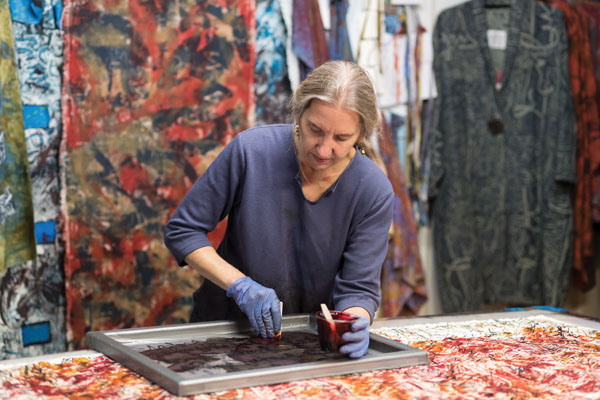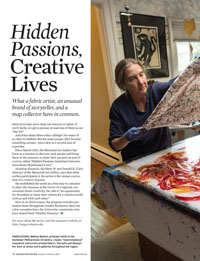Features
 MATERIALS ISSUE: Matson uses materials such as masking tape, glue, or flour paste—and even pine needles—to create visual interest in her fabrics. (Photo: Adam Fenster)
MATERIALS ISSUE: Matson uses materials such as masking tape, glue, or flour paste—and even pine needles—to create visual interest in her fabrics. (Photo: Adam Fenster)Melissa Matson ’78E, ’80E (MM) has always liked to “make stuff.”
Growing up in northern California, she made forts in the walnut trees on her family’s property. She followed along when TV’s Captain Kangaroo brought out his shoebox full of craft supplies and embarked on a new project using a milk carton or another found object. She learned to sew at a young age, and looked forward to family trips to Britex, a fabric store in San Francisco where she would “bask in all the fabrics.”
Matson is principal violist with the Rochester Philharmonic Orchestra and an associate professor of orchestral repertory at the Eastman School of Music. But she hasn’t stopped making things. These days she finds a creative outlet in making colorful artisan-dyed fabric and garments— something she’s been doing for about 15 years.
Inside the second-floor studio in her Honeoye Falls home hang dyed pieces of many sizes and colors, as well as completed jackets and scarves. She honed her skills at a screen printing workshop with Jane Dunnewold, whose book, Complex Cloth, first got Matson interested in the art. Dunnewold uses ordinary household materials such as masking tape, glue, and flour paste on her screens before dyeing, depending on the desired effect. She calls her method “improvisational,” and it’s an approach Matson has embraced.
“I just keep experimenting and see where it goes. Each piece is unique,” Matson says, proudly. Some are inspired by the rhythm of poetry. Some are the result of experimentation with color and texture. Some have more of a personal touch.
Matson pulls out a jacket and gently fingers screen-printed images of her mother and grandmother as little girls—they are enveloped by the bold, gold pattern covering the piece. She says her mother supported her interests and encouraged her to experiment on her sewing projects as a child.
Her background as a musician sometimes influences her creations. “People say that my fabrics look musical,” she says. “I think that has a lot to do with the flow and emotion that come when I play [music]. The fabrics I’ve made that I like the least are the ones that just sit there and don’t really have any motion.”
She’s found parallels between being a musician and a fabric artist. She says she’s always striving to find a better way to make music—a richer phrase or more interesting color in her playing. She takes the same approach to dyeing fabric.
There are differences, too. For example, playing music with the orchestra is more collaborative than the solo work of dyeing fabrics.
“This is a little freeing, but also adds more responsibility, because it’s all me,” Matson says about screen printing. “If it’s great, it’s me. If it’s ugly, it’s me.
“What’s nice about fabric making is that it frees me from the fear of making mistakes. There are no mistakes when I’m dyeing fabric. If I do something unexpected, it could be a really great discovery or it could be really bad.
“But I can always dye it again. I always say that if at first you don’t succeed, dye, dye again.” —Jennifer Roach

